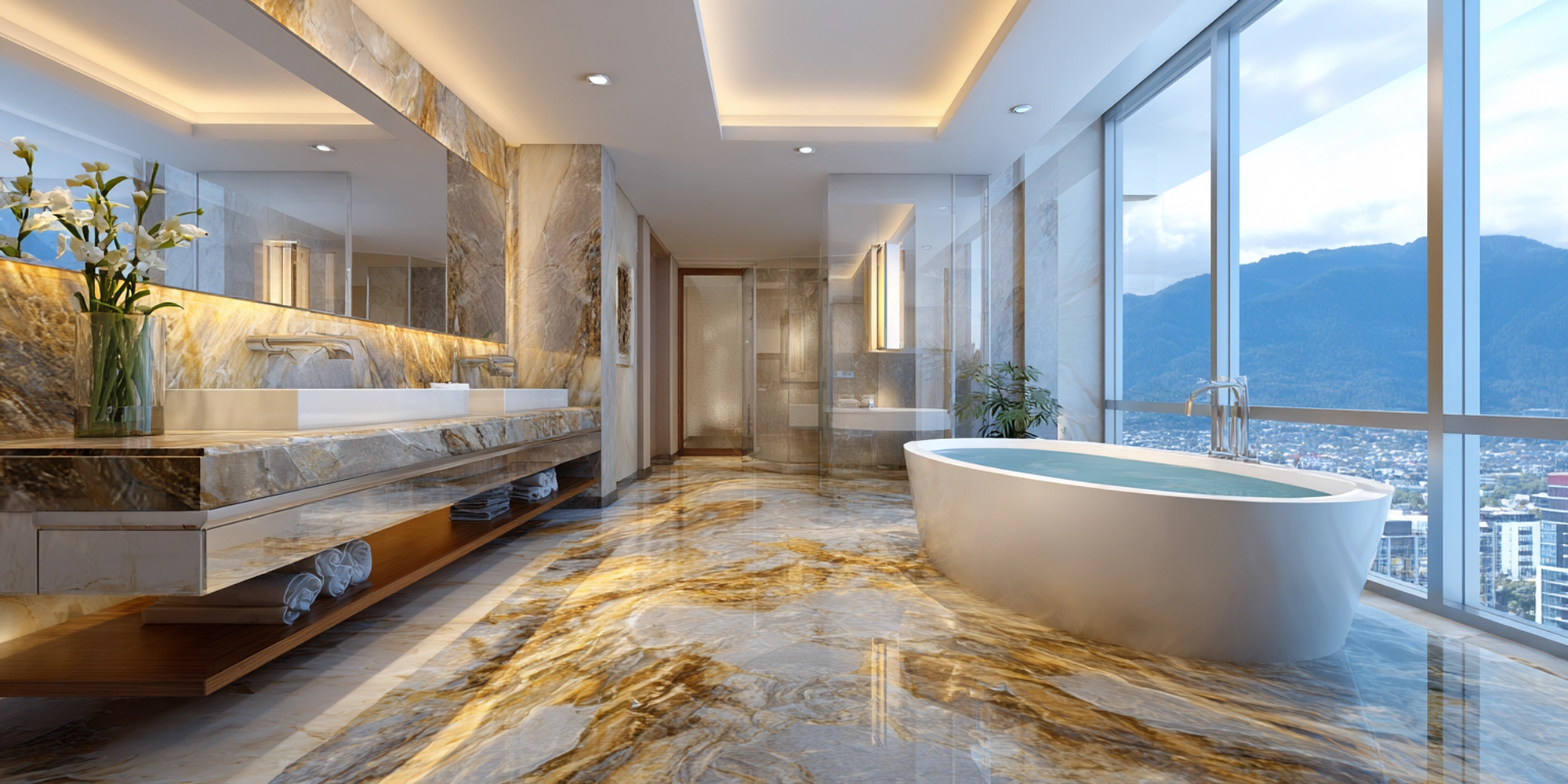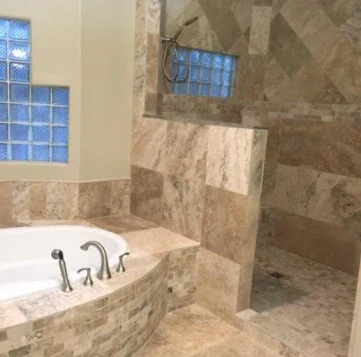
Real help. Real fast.
Call or text (650) 215-6464
Most replies within minutes · Mon–Fri 8–5 PT
Or [email protected] 24/7

Call or text (650) 215-6464
Most replies within minutes · Mon–Fri 8–5 PT
Or [email protected] 24/7


Summary: Home is a place where you find peace, solace, and a sense of ownership. Every detail matters when designing the high-end interior spaces of your luxury home. From the perfect color palette to the most exquisite finishes, each element contributes to the overall aesthetics, functionality, and safety of the space.
One crucial aspect that often goes overlooked is the slip resistance of the tiles used in various areas of the home. Choosing tiles with the appropriate slip resistance rating is not only essential for the safety of the occupants but also for the longevity and durability of the flooring.
Let’s walk into the world of tile slip resistance ratings to understand the different rating systems, their significance, and how to select the best tiles for your dream home or interior design project.
About the Author: Elchin, co-founder of Solidshape, brings over 20 years of design experience. He’s consulted on hundreds of projects—from malls to luxury homes—and is known for helping clients make smart, stylish tile choices.
It is a measure of a tile’s ability to prevent slips and falls in various conditions, such as when the surface is wet or oily. Tile slip resistance rating ratings help homeowners, designers, and builders make informed decisions about the most suitable tiles for specific areas of a home or commercial space.
For instance, a busy family with young children and pets may prioritize slip resistance in high-traffic areas like the kitchen or bathroom to minimize the risk of accidents. In a commercial space, the operations floor demands prioritization of installing the tiles.
Several factors influence a tile’s slip resistance, including:
Tiles with a slightly textured or matte finish generally offer more traction than smooth, glossy tiles.

The type of glaze or coating applied to the tile surface can impact its slip resistance. Some finishes are designed to enhance slip resistance, while others may make the surface more slippery.


The level of slip resistance required may vary depending on the specific location and conditions. For example, outdoor tiles exposed to rain or pool areas will need higher slip resistance than indoor tiles in a low-traffic bedroom.
Tile slip resistance ratings play a vital role in ensuring the safety of the occupants and minimizing the risk of slips and falls.
| Note: Alongside the personal well-being of the homeowners, their families, and guests, considering slip resistance is crucial for complying with building codes and regulations, It also reduces the potential for liability issues in case of accidents. The American National Standards Institute (ANSI) A137.1 standard requires a minimum Dynamic Coefficient of Friction (DCOF) of 0.42 for tiles in wet conditions to ensure safety. |
There are several tile slip resistance rating systems used worldwide, each with its own testing methods and criteria.
The R-Value rating system, also known as the Ramp Test, is a popular method for measuring tile slip resistance in Europe and Australia. This system evaluates the angle at which a person slips on a tile surface under controlled conditions, providing a clear indication of the tile’s slip resistance properties.
The R-Value ratings range from R9 (least slip-resistant) to R13 (most slip-resistant), with each rating suitable for specific applications.
Here’s a breakdown of the R-Value ratings and their recommended applications:
This rating is suitable for dry areas with minimal slip risk, such as bedrooms or living rooms. Tiles with an R9 rating provide a basic level of slip resistance and are a good choice for spaces where the likelihood of slips and falls is low.
Tiles with an R10 rating are ideal for areas with occasional moisture, like bathrooms or kitchens.
With a moderate level of slip resistance, this rating ensures safety in areas having slight risk of slips due to water or other liquids.
For areas with frequent exposure to water or grease, such as commercial kitchens or pool surrounds, tiles with an R11 rating are recommended.
These tiles provide a high level of slip resistance, ensuring the safety of users in environments where the risk of slips and falls is increased.
These ratings are designed for high-risk areas with constant exposure to water, oil, or grease, like industrial kitchens or outdoor ramps.
Tiles with R12 or R13 ratings offer the highest level of slip resistance, making them essential for spaces where safety is of utmost importance.
These ratings are specifically used for extremely high-risk areas like industrial kitchens or fish processing plants.
You should consider the specific needs of each area and choose the appropriate R-value rating accordingly.
For example, in a master bathroom with a large walk-in shower, opting for tiles with an R11 rating or higher can provide added peace of mind and prevent accidents.
The COF (Coefficient of Friction) rating system is another method for evaluating tile slip resistance. This system measures the friction between the tile surface and a sliding object, such as a shoe or foot.
The higher the COF value, the more slip-resistant the tile is considered to be. The COF rating system is divided into two categories:
This measures the friction required to initiate movement between the tile surface and an object. In other words, it determines the amount of force needed to overcome the tile’s resistance and start sliding.
This measures the friction required to maintain movement between the tile surface and an object. It evaluates the tile’s ability to prevent slipping once motion has already begun.
In the United States, the DCOF AcuTest is the most widely accepted method for measuring the slip resistance of ceramic tiles. The American National Standards Institute (ANSI) recommends a minimum DCOF value of 0.42 for level interior ceramic tile surfaces that are expected to be walked on when wet.
For luxury homeowners and interior designers, understanding the COF rating system and the minimum recommended values can help ensure that the tiles selected for a project meet the necessary safety standards. When choosing tiles for areas like bathrooms, kitchens, or outdoor spaces, opting for products with a DCOF value of 0.42 or higher can help reduce the risk of slips and falls.
The ANSI rating system is the most common tile slip resistance rating system in North America. It is based on the ANSI A137.1 standard for ceramic tiles and uses the BOT 3000 test method to measure the DCOF of a tile surface.
In 2017, the ANSI A326.3 standard was released, providing guidelines for measuring the DCOF of hard surface flooring materials, including ceramic tiles, porcelain tiles, and natural stone.
According to this standard, tiles are classified into three categories based on their DCOF values:
Tiles with a DCOF value of less than 0.42 are suitable for areas that are expected to be dry most of the time, such as bedrooms or home offices.
For areas that may be exposed to moisture, like bathrooms or kitchens, tiles with a DCOF value of 0.42 or greater are recommended. These tiles provide a higher level of slip resistance, making them safer for use in wet conditions.
Tiles with a DCOF value of 0.60 or greater are designed for outdoor areas or spaces exposed to significant moisture. These tiles offer the highest level of slip resistance, ensuring the safety of users in environments where the risk of slips and falls is greatest.
By choosing tiles with the appropriate DCOF values, you can create beautiful and functional spaces that prioritize safety and well-being .
Experienced professionals can provide valuable guidance and ensure that the tiles selected meet both the aesthetic and safety requirements of the space.
There are three significant factors to consider while choosing the right slip resistance rating for your tiles – identifying high-risk areas, considering user needs and preferences, and finding the perfect balance between slip resistance and aesthetics.
Here’s a breakdown of all three:
Some areas of the home are more prone to slips and falls due to the presence of water, grease, or other slippery substances. As a homeowner or interior designer, it’s essential to identify these high-risk areas and prioritize slip resistance when selecting tiles. The most common high-risk areas include:

Showers, tub surrounds, and bathroom floors are constantly exposed to water and moisture, making slip resistance a top priority. Wet bathroom surfaces can be dangerous, so it’s crucial to choose tiles with excellent traction.

Kitchen floors, particularly areas near the sink or stove, can become slippery due to spills and splashes. Cooking grease, water, and other liquids can create hazardous conditions, so it’s important to select tiles with adequate slip resistance.

Patios, pool decks, and walkways are subject to rain, snow, and other weather conditions that can make surfaces slippery. Outdoor areas also face the challenge of algae and moss growth, which can further increase the risk of slips and falls.
For these high-risk areas, it’s essential to choose tiles with higher slip resistance ratings, such as R11 or above (using the R-Value system) or a DCOF value of 0.60 or greater (using the ANSI system).
These ratings ensure that the tiles provide excellent traction, even when exposed to water or other slippery substances, minimizing the risk of accidents and injuries.
It’s essential to consider the specific needs and preferences of the users who will be living in or visiting the space. Here are some key factors to keep in mind:
If your home has elderly residents or individuals with mobility issues, choose tiles with higher slip resistance ratings. This will help reduce the risk of falls and make it easier for them to navigate the space safely.
Families with young children or pets may want to prioritize slip resistance in high-traffic areas like hallways, kitchens, and living rooms. Children and pets are more prone to slips and falls, so select tiles with good traction to prevent accidents and create a safer environment.
Some homeowners may prefer a more polished or glossy look for their tiles, which can be challenging when trying to achieve high slip resistance. However, with advancements in tile technology, it’s now possible to find tiles that offer both excellent slip resistance and stunning aesthetics.
Homeowners often worry that tiles with high slip resistance ratings will compromise the visual appeal of their home. With the wide range of options available today, it’s possible to find tiles that offer both safety and style.
Many tile manufacturers now offer products with advanced slip-resistant technologies that maintain the tile’s aesthetic appeal. For example, some tiles feature micro-textures or special glazes that enhance traction without detracting from the tile’s appearance. This indicates you can choose tiles with high slip resistance ratings without sacrificing the look and feel of your space.
To balance slip resistance and aesthetics, consider working with experienced professionals who can guide you through the process. The experts at Solidshape can help you find the perfect balance between slip resistance and aesthetics, ensuring that your space is both safe and beautiful.
At Solidshape, we understand the importance of combining safety, durability, and style when selecting tiles for luxury homes and high-end interior design projects. Our curated collection of premium tiles features a diverse range of options with superior slip resistance ratings, ensuring that you can find the perfect tiles to suit your specific needs and design preferences.
Our extensive selection includes tiles in various materials, such as porcelain, ceramic, and natural stone, each offering unique benefits and characteristics:

Known for their durability and versatility, porcelain tiles are an excellent choice for high-traffic areas and spaces exposed to moisture. Many of our porcelain tiles feature advanced slip-resistant technologies, making them a perfect option for bathrooms, kitchens, and outdoor spaces.

Ceramic tiles offer a wide range of design options and can be treated with slip-resistant glazes or finishes. Our collection includes ceramic tiles with excellent traction, ideal for both residential and commercial applications.

Natural stone tiles, such as granite, slate, or travertine, offer a timeless and luxurious look. Many natural stone tiles have inherent slip-resistant properties due to their textured surfaces. We offer a selection of natural stone tiles with exceptional slip resistance ratings, perfect for creating a safe and stylish space.
When you choose Solidshape for your luxury home or interior design project, you can have peace of mind knowing that you are investing in high-quality, slip-resistant tiles that will enhance the safety, durability, and aesthetics of your space. Our knowledgeable team is dedicated to helping you find the perfect tiles that meet your specific needs and design vision, ensuring a successful and stunning outcome for your project. Explore More ▶️
Choosing tiles with the appropriate slip resistance rating is just the first step in ensuring the safety and longevity of your flooring. Proper maintenance and care are essential to preserve the slip resistance of your tiles over time.
To maintain the slip resistance of your tiles, it’s crucial to follow a regular cleaning and maintenance routine. This includes:
| Note: While purchasing tiles for your home interiors, check with your manufacturer/supplier for the right cleaning methods and products. The needs and demands could differ depending on the type of tiles you choose. Our experts can help you understand the type of cleaning products to use for the selected type. Feel free to reach out to us for assistance. |
Some common mistakes can inadvertently reduce the slip resistance of your tiles, compromising the safety of your flooring. To avoid these pitfalls:
By following these simple maintenance tips and avoiding common mistakes, you can ensure that your tiles retain their slip resistance and continue to provide a safe and durable surface for years.
By prioritizing safety without compromising on style, you can create beautiful, functional, and secure spaces that stand the test of time.
At Solidshape, we are committed to helping you navigate the world of tile slip resistance ratings and make informed decisions for your project. Our premium tile collection offers a wide range of options with superior slip resistance ratings, ensuring that you can find the perfect tiles to suit your specific needs and design preferences.
Explore our extensive selection of tiles and consult with our knowledgeable experts to find the best solutions for your luxury home or interior design project.
The slip resistance value of a tile is a measure of its ability to prevent slips and falls. This value is determined by factors such as the tile’s surface texture, finish, and the environment in which it will be used.
The higher the slip resistance value, the more traction the tile offers, making it safer to walk on in various conditions.
An R10 slip rating is part of the R-Value (Ramp Test) rating system, which is commonly used in Europe and Australia. Tiles with an R10 rating are suitable for areas with occasional moisture, such as residential bathrooms or kitchens. They offer a moderate level of slip resistance and are a good choice for most household applications.
However, for high-risk areas like commercial kitchens or outdoor spaces, tiles with higher R-Value ratings, such as R11 or above, may be more appropriate.
An R11 slip rating indicates that a tile offers a high level of slip resistance, making it suitable for areas with frequent exposure to water or grease. Tiles with an R11 rating are commonly used in commercial kitchens, pool surrounds, and other high-risk areas where the safety of the occupants is a top priority.
The R11 rating is part of the R-Value (Ramp Test) rating system and signifies that the tile surface provides excellent traction, even in wet or slippery conditions.
The best anti-slip rating for tiles depends on the specific application and the level of slip resistance required. For high-risk areas like industrial kitchens, outdoor ramps, or spaces with constant exposure to water, oil, or grease, the highest anti-slip ratings, such as R12 or R13 in the R-Value system or a DCOF value of 0.60 or greater in the ANSI system, are recommended.
However, for residential applications, such as bathrooms or kitchens, tiles with an R10 or R11 rating, or a DCOF value of 0.42 or greater, may be sufficient. It’s essential to consider factors such as the intended use of the space, the level of foot traffic, and the potential for exposure to moisture or slippery substances when selecting the best anti-slip rating for your project.
Consulting with experts, like those at Solidshape, can help you make the right decision and choose the optimal anti-slip rating for your specific needs.